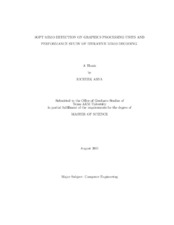| dc.contributor.advisor | Choi, S. Gwan | |
| dc.creator | Arya, Richeek | |
| dc.date.accessioned | 2012-10-19T15:29:32Z | |
| dc.date.accessioned | 2012-10-22T18:06:03Z | |
| dc.date.available | 2012-10-19T15:29:32Z | |
| dc.date.available | 2012-10-22T18:06:03Z | |
| dc.date.created | 2011-08 | |
| dc.date.issued | 2012-10-19 | |
| dc.date.submitted | August 2011 | |
| dc.identifier.uri | https://hdl.handle.net/1969.1/ETD-TAMU-2011-08-10147 | |
| dc.description.abstract | In this thesis we have presented an implementation of soft Multi Input Multi Output (MIMO) detection, single tree search algorithm on Graphics Processing Units (GPUs). We have compared its performance on different GPUs and a Central Processing Unit (CPU). We have also done a performance study of iterative decoding algorithms. We have shown that by increasing the number of outer iterations error rate performance can be further improved. GPUs are specialized devices specially designed to accelerate graphics processing. They are massively parallel devices which can run thousands of threads simultaneously. Because of their tremendous processing power there is an increasing interest in using them for scientific and general purpose computations. Hence companies like Nvidia, Advanced Micro Devices (AMD) etc. have started their support for General Purpose GPU (GPGPU) applications. Nvidia came up with Compute Unified Device Architecture (CUDA) to program its GPUs. Efforts are made to come up with a standard language for parallel computing that can be used across platforms. OpenCL is the first such language which is supported by all major GPU and CPU vendors.
MIMO detector has a high computational complexity. We have implemented a soft MIMO detector on GPUs and studied its throughput and latency performance. We have shown that a GPU can give throughput of up to 4Mbps for a soft detection algorithm which is more than sufficient for most general purpose tasks like voice communication etc. Compare to CPU a throughput increase of ~7x is achieved. We also compared the performances of two GPUs one with low computational power and one with high computational power. These comparisons show effect of thread serialization on algorithms with the lower end GPU's execution time curve shows a slope of 1/2.
To further improve error rate performance iterative decoding techniques are employed where a feedback path is employed between detector and decoder. With an eye towards GPU implementation we have explored these algorithms. Better error rate performance however, comes at a price of higher power dissipation and more latency. By simulations we have shown that one can predict based on the Signal to Noise Ratio (SNR) values how many iterations need to be done before getting an acceptable Bit Error Rate (BER) and Frame Error Rate (FER) performance. Iterative decoding technique shows that a SNR gain of ~1:5dB is achieved when number of outer iterations is increased from zero. To reduce the complexity one can adjust number of possible candidates the algorithm can generate. We showed that where a candidate list of 128 is not sufficient for acceptable error rate performance for a 4x4 MIMO system using 16-QAM modulation scheme, performances are comparable with the list size of 512 and 1024 respectively. | en |
| dc.format.mimetype | application/pdf | |
| dc.language.iso | en_US | |
| dc.subject | MIMO Detection | en |
| dc.subject | Iterative Decoding | en |
| dc.subject | GPU | en |
| dc.subject | OpenCL | en |
| dc.subject | CUDA | en |
| dc.subject | Soft MIMO Detection | en |
| dc.title | Soft MIMO Detection on Graphics Processing Units and Performance Study of Iterative MIMO Decoding | en |
| dc.type | Thesis | en |
| thesis.degree.department | Electrical and Computer Engineering | en |
| thesis.degree.discipline | Computer Engineering | en |
| thesis.degree.grantor | Texas A&M University | en |
| thesis.degree.name | Master of Science | en |
| thesis.degree.level | Masters | en |
| dc.contributor.committeeMember | Bettati, Riccardo | |
| dc.contributor.committeeMember | Reddy, A. L. Narasimha | |
| dc.type.genre | thesis | en |
| dc.type.material | text | en |


